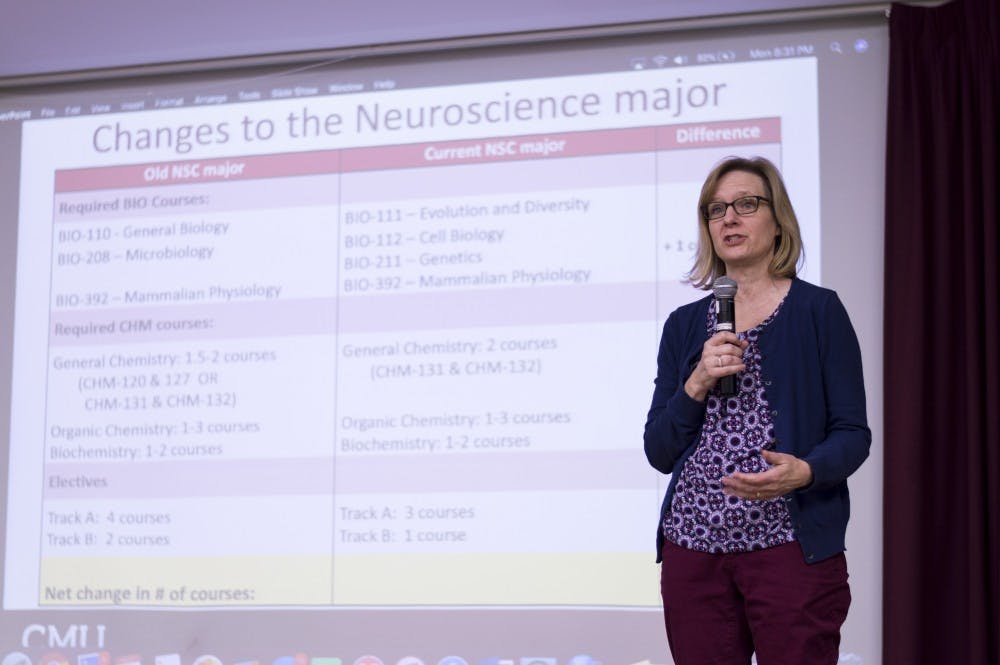SGA passes neuroscience and fall break legislation at Nov. 19 meeting
Faculty members offered differing opinions on neuroscience reorganization

Biology faculty member Cynthi Damer speaks about the proposed neuroscience program reorganization at the SGA meeting on Nov. 19 in the Bovee University Center Auditorium.
Two pieces of legislation were passed by Central Michigan University Student Government Association at House and Senate meetings Nov. 19.
The first was a proposal from the Central Neuroscience Society, "A Resolution in Student Body Support of the Neuroscience Program Reorganization," which was first introduced to SGA on Nov. 5.
The legislation, which was passed unanimously by both House and Senate, sought student body support of a proposed reorganization of the CMU undergraduate neuroscience program.
The proposal seeks the creation of an official School of Neuroscience, as well as proposed foundational courses that would fall under specific neuroscience (NSC) course designators.
Student Government Association meets at 7 p.m. Mondays in the Bovee University Center Auditorium. Meetings are free to attend, but students must bring their CMU Global ID cards to check in prior to entering.
The Nov. 19 meeting offered a wide variety of dissenting opinions from neuroscience faculty members about the current state of the undergraduate program. The debate lies mostly in the structure of core science requirements for the program.
Invited speakers included Ian Davison, interim senior vice provost of academic affairs, and biology faculty members Cynthia Damer and Shasta Sabo, who provided their perspectives as to why legislation did not accurately represent the state of the neuroscience program.
Davison asserted that, while the proposal opposed an interdisciplinary neuroscience program, CMU's undergraduate neuroscience program matched that of peer institutions across the state in terms of its core science requirements.
CMU's interdisciplinary neuroscience program currently falls under four separate departments: biology, chemistry, health sciences and psychology.
Damer said that, in terms of core science requirements (courses such as biology, organic chemistry and biochemistry), the program is similar to others in giving a foundational science education to neuroscience.
"Without these courses, we would create a weaker program," she said.
However, many neuroscience students expressed frustration in not being able to take neuroscience classes in their first few years of school, as they are occupied taking course designators in other core science departments.
Lake Orion junior Shelby Miller, president of the Central Neuroscience Society and invited speaker at the Nov. 19 meeting, shared her disappointment in not being able to take neuroscience courses until her junior year at CMU.
"I decided to come to this school for neuroscience and to this day have not taken a neuroscience course," she said.
Miller spoke to SGA alongside psychology and neuroscience faculty members Gary Dunbar and Michael Sandstrom, who advocated for the creation of introductory neuroscience courses so students may take neuroscience courses during their first undergraduate years.
But, according to some neuroscience faculty members, these introductory courses are unnecessary because the currently required core science courses already lay an important foundation for a deeper understanding of neuroscience.
"It's disappointing when I hear students say certain (core science courses) are a waste of time," said Kevin Park, psychology and neuroscience faculty member. "You can't ignore biology and chemistry with neuroscience, because it's interdisciplinary. It's not all-or-none."
Psychology faculty member Yannick Marchalant said although there is a division between neuroscience faculty members, all can agree there aren't enough neuroscience courses.
"But that doesn't mean we need to get rid of other foundational science courses," Marchalant said. "It's not a battle over tuition dollars."
Davison explained four proposals were submitted to Committee I during the 2017-2018 Academic Organizational Review regarding a neuroscience reorganization.
"There was considerable disagreement among the relatively small number of neuroscience faculty members," Davison said. "None of the proposals were considered to be viable, and strengthening the interdisciplinary program was considered the best option for the immediate future."
With the support of SGA, the Central Neuroscience Society hopes to take this proposal to the CMU Board of Trustees in December.
However, Davison said that SGA support of the legislation doesn't mean it will immediately go into effect. When there is a proposed reorganization, it requires a vote from every affected department.
"The board of trustees would not make a decision affecting the biology department without first talking to the biology department," he explained.
Davison emphasized that, alongside President Robert Davies, administrators are fully committed to maintaining high-quality programs for all CMU students, including those in the neuroscience program.
Fall Break legislation
House and Senate also unanimously voted in favor of passing a piece of legislation in favor of a new fall break, "A Resolution to Implement a Fall Break in Central Michigan University’s Academic Calendar," which was introduced to SGA last year.
The legislation states CMU’s academic calendar currently includes only three days off of classes in the average fall academic semester. It lists 15 peer institutions that offer fall break for their students.
After passing in SGA, the legislation will next go to Academic Senate, which meets at 3:30 p.m. on Tuesday, Nov. 20 in Pearce 127.



